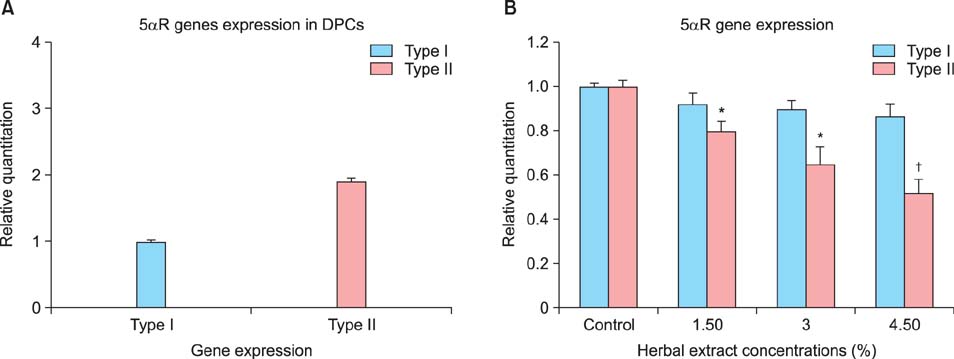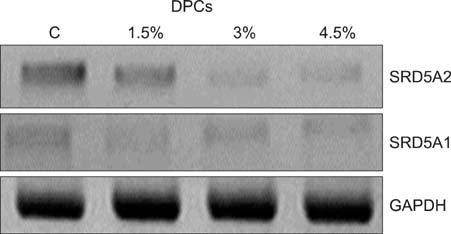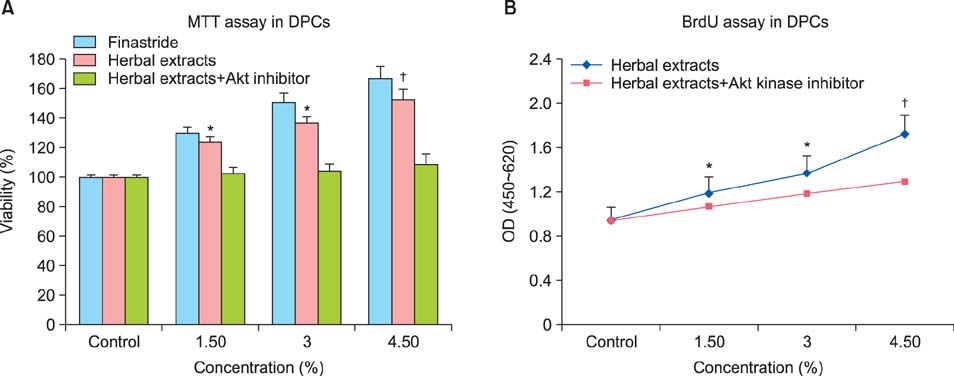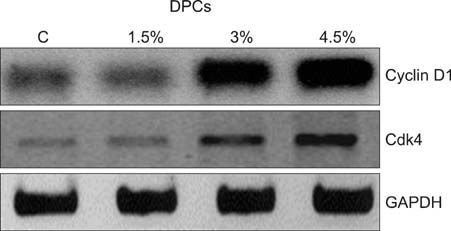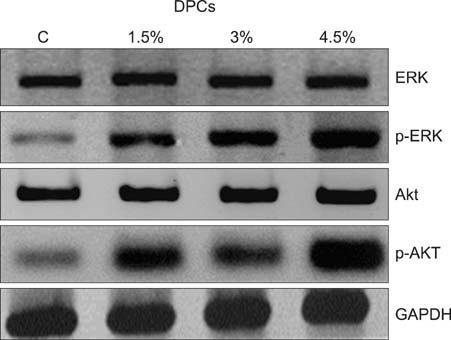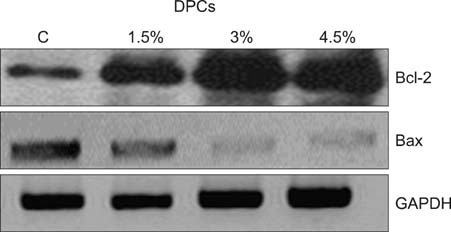Ann Dermatol.
2015 Dec;27(6):667-675. 10.5021/ad.2015.27.6.667.
Herbal Extracts Induce Dermal Papilla Cell Proliferation of Human Hair Follicles
- Affiliations
-
- 1Food and Drug Control Laboratory and Research Center, Tehran, Iran.
- 2Islamic Azad University, Pharmaceutical Sciences Branch, Tehran, Iran. ahmadi@iaups.ac.ir
- 3Department of Clinical Biochemistry, School of Pharmacy and Isfahan Pharmaceutical Sciences Research Center, Isfahan University of Medical Sciences, Isfahan, Iran.
- 4Laser Application in Medical Sciences Research Center, Shahid Beheshti University of Medical Sciences, Tehran, Iran.
- 5Tehran University of Medical Science, Razi Hospital, Tehran, Iran.
- KMID: 2157441
- DOI: http://doi.org/10.5021/ad.2015.27.6.667
Abstract
- BACKGROUND
The number of people suffering from balding or hair thinning is increasing, despite the advances in various medical therapies. Therefore, it is highly important to develop new therapies to inhibit balding and increase hair proliferation.
OBJECTIVE
We investigated the effects of herbal extracts commonly used for improving balding in traditional medicine to identify potential agents for hair proliferation.
METHODS
The expression levels of 5alpha-reductase isoforms (type I and II) were analyzed using quantitative real-time reverse transcription polymerase chain reaction in the human follicular dermal papilla cells (DPCs). The 3-(4,5-dimethylthiazol-2-yl)-2,5-diphenylteterazolium bromide and bromodeoxyuridine tests were used to evaluate the cell proliferation effect of herbal extracts in DPCs. The expression levels of extracellular signal-regulated kinase (ERK), Akt, cyclin D1, cyclin-dependent kinase 4 (Cdk4), B-cell lymphoma (Bcl-2) and Bcl-2-associated X protein (Bax) were measured using western blot analysis.
RESULTS
The 5alpha-reductase isoform mRNAs and proteins were detected in the cultured DPCs, and the expression level of 5alpha-R2 in DPCs in the presence of the herbal extracts was gradually decreased. Herbal extracts were found to significantly increase the proliferation of human DPCs at concentrations ranging from 1.5% to 4.5%. These results show that the herbal extracts tested affected the protein expressions of ERK, Akt, cyclin D1, Cdk4, Bcl-2, and Bax in DPCs.
CONCLUSION
These results suggest that herbal extracts exert positive effects on hair proliferation via ERK, Akt, cyclin D1, and Cdk4 signaling in DPCs; they also suggest that herbal extracts could be a great alternative therapy for increasing hair proliferation.
MeSH Terms
-
bcl-2-Associated X Protein
Blotting, Western
Bromodeoxyuridine
Cell Proliferation*
Cyclin D1
Cyclin-Dependent Kinase 4
Hair Follicle*
Hair*
Humans*
Lymphoma, B-Cell
Medicine, Traditional
Phosphotransferases
Polymerase Chain Reaction
Protein Isoforms
Reverse Transcription
RNA, Messenger
Bromodeoxyuridine
Cyclin D1
Cyclin-Dependent Kinase 4
Phosphotransferases
Protein Isoforms
RNA, Messenger
bcl-2-Associated X Protein
Figure
Reference
-
1. Paus R, Müller-Röver S, Botchkarev VA. Chronobiology of the hair follicle: hunting "the hair cycle clock". J Investig Dermatol Symp Proc. 1999; 4:338–345.
Article2. Thornton MJ, Messenger AG, Elliott K, Randall VA. Effect of androgens on the growth of cultured human dermal papilla cells derived from beard and scalp hair follicles. J Invest Dermatol. 1991; 97:345–348.
Article3. Randall VA. Hormonal regulation of hair follicles exhibits a biological paradox. Semin Cell Dev Biol. 2007; 18:274–285.
Article4. Randall VA, Hibberts NA, Thornton MJ, Hamada K, Merrick AE, Kato S, et al. The hair follicle: a paradoxical androgen target organ. Horm Res. 2000; 54:243–250.
Article5. Russell DW, Wilson JD. Steroid 5 alpha-reductase: two genes/two enzymes. Annu Rev Biochem. 1994; 63:25–61.6. Anderson KM, Liao S. Selective retention of dihydrotestosterone by prostatic nuclei. Nature. 1968; 219:277–279.
Article7. Andersson S, Russell DW. Structural and biochemical properties of cloned and expressed human and rat steroid 5 alpha-reductases. Proc Natl Acad Sci U S A. 1990; 87:3640–3644.
Article8. Bhaumik S, Jyothi MD, Khar A. Differential modulation of nitric oxide production by curcumin in host macrophages and NK cells. FEBS Lett. 2000; 483:78–82.
Article9. Rathi V, Rathi JC, Tamizharasi S, Pathak Ak. Plants used for hair growth promotion: a review. Phcog Rev. 2008; 2:185–187.10. Banerjee PS, Sharma M, Nema RK. Preparation, evaluation and hair growth stimulating activity of herbal hair. J Chem Pharm Res. 2009; 1:261–267.11. Aghaei M, Karami-Tehrani F, Panjehpour M, Salami S, Fallahian F. Adenosine induces cell-cycle arrest and apoptosis in androgen-dependent and -independent prostate cancer cell lines, LNcap-FGC-10, DU-145, and PC3. Prostate. 2012; 72:361–375.
Article12. Randall VA, Thornton MJ, Hamada K, Redfern CP, Nutbrown M, Ebling FJ, et al. Androgens and the hair follicle. Cultured human dermal papilla cells as a model system. Ann NY Acad Sci. 1991; 642:355–375.13. Aghaei M, Panjehpour M, Karami-Tehrani F, Salami S. Molecular mechanisms of A3 adenosine receptor-induced G1 cell cycle arrest and apoptosis in androgen-dependent and independent prostate cancer cell lines: involvement of intrinsic pathway. J Cancer Res Clin Oncol. 2011; 137:1511–1523.
Article14. Lachgar S, Charveron M, Sarraute J, Mourard M, Gall Y, Bonafe JL. In vitro main pathways of steroid action in cultured hair follicle cells: vascular approach. J Investig Dermatol Symp Proc. 1999; 4:290–295.
Article15. Nakanishi S, Adachi IS, Takayasu KS. Expression of androgen receptor, type I and type II 5a-reductase in human dermal papilla cells. In : Neste D, editor. Hair research for the next millennium. Amsterdam: VREPB;1996. p. 333–337.16. Asada Y, Sonoda T, Ojiro M, Kurata S, Sato T, Ezaki T, et al. 5 alpha-reductase type 2 is constitutively expressed in the dermal papilla and connective tissue sheath of the hair follicle in vivo but not during culture in vitro. J Clin Endocrinol Metab. 2001; 86:2875–2880.
Article17. Hoffmann R, Happle R. Finasteride is the main inhibitor of 5alpha-reductase activity in microdissected dermal papillae of human hair follicles. Arch Dermatol Res. 1999; 291:100–103.
Article18. Robinson MJ, Cobb MH. Mitogen-activated protein kinase pathways. Curr Opin Cell Biol. 1997; 9:180–186.
Article19. Xia Z, Dickens M, Raingeaud J, Davis RJ, Greenberg ME. Opposing effects of ERK and JNK-p38 MAP kinases on apoptosis. Science. 1995; 270:1326–1331.
Article20. Jin S, Mazzacurati L, Zhu X, Tong T, Song Y, Shujuan S, et al. Gadd45a contributes to p53 stabilization in response to DNA damage. Oncogene. 2003; 22:8536–8540.
Article21. Ahmad S, Singh N, Glazer RI. Role of AKT1 in 17betaestradiol-and insulin-like growth factor I (IGF-I)-dependent proliferation and prevention of apoptosis in MCF-7 breast carcinoma cells. Biochem Pharmacol. 1999; 58:425–430.
Article22. Tang Y, Zhou H, Chen A, Pittman RN, Field J. The Akt proto-oncogene links Ras to Pak and cell survival signals. J Biol Chem. 2000; 275:9106–9109.
Article23. Adams JM, Cory S. The Bcl-2 protein family: arbiters of cell survival. Science. 1998; 281:1322–1326.
Article24. Tamamori-Adachi M, Ito H, Sumrejkanchanakij P, Adachi S, Hiroe M, Shimizu M, et al. Critical role of cyclin D1 nuclear import in cardiomyocyte proliferation. Circ Res. 2003; 92:e12–e19.
Article25. Roh SS, Kim CD, Lee MH, Hwang SL, Rang MJ, Yoon YK. The hair growth promoting effect of Sophora flavescens extract and its molecular regulation. J Dermatol Sci. 2002; 30:43–49.
Article26. Rho SS, Park SJ, Hwang SL, Lee MH, Kim CD, Lee IH, et al. The hair growth promoting effect of Asiasari radix extract and its molecular regulation. J Dermatol Sci. 2005; 38:89–97.
Article27. Hay IC, Jamieson M, Ormerod AD. Randomized trial of aromatherapy. Successful treatment for alopecia areata. Arch Dermatol. 1998; 134:1349–1352.28. Bureau JP, Ginouves P, Guilbaud J, Roux ME. Essential oils and low-intensity electromagnetic pulses in the treatment of androgen-dependent alopecia. Adv Ther. 2003; 20:220–229.
Article29. Hoffmann R, Happle R. Current understanding of androgenetic alopecia. Part I: etiopathogenesis. Eur J Dermatol. 2000; 10:319–327.
- Full Text Links
- Actions
-
Cited
- CITED
-
- Close
- Share
- Similar articles
-
- Effects of Alopecia Areata Serum on Proliferation of Cultured Dermal Papilla Cells
- Effect of Chrysanthemum zawadskii Extract on Dermal Papilla Cell Proliferation and Hair Growth
- Effects of Vaseular Endothelial Growth Factors on Hair Growth in Vitro
- Effects of Substance P on the Expression of Various Factors to control Hair Growth in Human Hair Follicle Culture
- Hair Growth Promoting Potential of Phospholipids Purified from Porcine Lung Tissues

